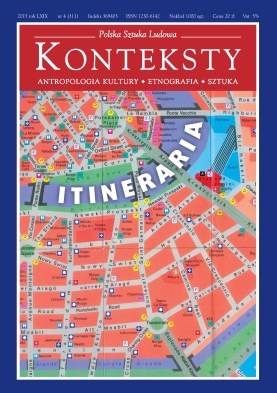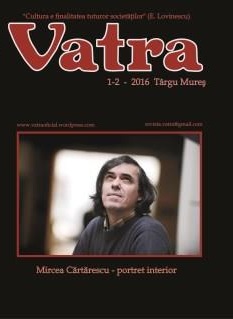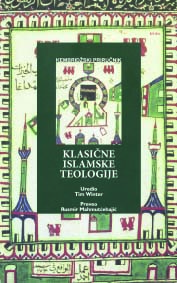


Keywords: itineraries; anthropology
This conversation about Podróżnicy bez mapy i paszportu. Michel Leiris i ”Documents”, took place on 18 June 2015 at the Museum of Modern Art in Warsaw.
More...
Keywords: art; anthropology; Jacek Sempoliński
An essay about paintings by Jacek Sempoliński (1927-2012).
More...
Keywords: Anselm Kiefer; anthropology; art
Recently, the oeuvre of the German artist Anselm Kiefer, brimming with references to historical events, Germanic, Nordic, Egyptian, and Middle Eastern mythology as well as assorted religions features intensified interest in Jewish mysticism. The intention of the author of this article is to decode the artist’s particular works explicitly referring via the title or the visual stratum to ideas derived from the written sources of the Kabbalah (The Book of Creation, Etz Chaim) as well as those preceding them (Hekhalot). Particular conceptions of Jewish mysticism present in the works of Anselm Kiefer – the journey across seven celestial palaces and communing with the Throne of God, His emanations (Sefirot), the female element (Shekhinah), the Tree of Life, the pre-catastrophe (shattered vessels), God’s withdrawal (tzimtzum) and the rectification of the world (tikkun) – comprise the structural axis of the text and were presented upon the basis of works by Gershom Scholem. A discussion about successive mystical ideas is accompanied by matching them with the artist’s concrete works. The author also proposed to insert into the context of Jewish mysticism those of Krieger’s works that originated before the artist became interested in Judaism as well as those, which literally referred to cultural circles other than the Judaeo-Christian one (e.g. the myth of Osiris and Isis). At the same time, the analysis refers to such themes as material (e.g. lead). The author perceives the presence of the Kabbalah shevira – a mystical catastrophe – in a considerable number of the artist’s works referring to destruction, including those evoking the Holocaust and thus opposing the universally held view linking Kiefer’s oeuvre with a readiness to work through the traumatic lineage of the German nation.
More...
Keywords: photography; anthropology; portrait
The peasant (group) posthumous portrait is one of the four canons of posthumous photography executed in Poland in the last century. This text attempts to analyse five portraits upon the basis of the specificity of peasant culture. The interpretation is based on the mythopoeic potential of the camera, which assists in telling stories about the passage of time, the changing generations, the transmission of genes and tradition, man’s place on Earth, and the place he goes to after death.
More...
Keywords: art; anthropology; Morton Bartlett
The text deals with concept of the Uncanny (das Unheimliche) in context of the (art)works presented between 2011 and 2013 within the four-part project secret universe run by the Berlin’s Hamburger Bahnhof. To present my identifications concerning the notion of the Uncanny I am referring to Bartlett’s oeuvre. For nearly thirty years, he has been following his passion for the Uncanny. Bartlett has developed an extensive and intimate practice of creating dolls, from carving their shapes through designing the entire wardrobe, to performing the dolls live-like, narrative acts which he then photographed and put aside. Bartlett’s mysterious family is an excellent foundation for the analysis of the Uncanny concept initially introduced by Sigmund Freud in his 1919 essay Das Unheimliche. I will also investigate the category of Disgust as used by Sara Ahmed in her essay The performativity of disgust and inquire, which emotion / affect, uncanny or disgust, is more adequate for describing Bartlett works.
More...
Keywords: anthropology; puppet; Malagasy culture; theatre
The authors of the reviewed book undertook the task of a detective tracing Malagasy customs as well as those of the inhabitants of neighbouring islands. Naturally, myths were preserved and today speak of the creation of man in local conditions. Puppets, however, left behind scarce traces; some are to be found in Swiss and French museums and display distinctive natural features. Old illustrations also testify to the existence of à la Planchette puppets (dancing on a small plank). Extant para-theatrical forms include the theatre of seeds and beads or stories told with stone figures. The theatrical instinct urges the population of the island to create figurines portraying persons encountered in daily life or to adorn a gravestone pillar with statuettes. Other surviving forms include the Ngoma dance performed under a huge hat or funereal games played with the corpse of the deceased. Magic practices using mirror fragments or fertility sticks with female heads have also endured. The former hegemony of the French is recalled in Guignol de Lyon, which, however, does not fulfil noble functions similar to those performed in its homeland.
More...





Keywords: Józef Chrobak;
More...

Keywords: Józef Chrobak;
More...
Keywords: Józef Chrobak;
More...

Keywords: Aurel Pantea; Delmore Schwartz; Bogdan Ghiu; Viorel Mureşan; Şerban Tomşa;Alex Goldiş; Francisko Kocsis; Alex Ciorogar; Adriana Moica; Ioan Moldovan; Rareş Moldovan; Mircea Cărtărescu;
THE NEW PRESENTATION OF VATRA IN CEEOL WILL OFFER ALWAYS THE FULL ISSUE OF THE JOURNAL IN ONE SINGLE PDF FILE. BEFORE DOWNLOOADING THE ISSUE-FILE READERS SEARCHING FOR SPECIAL ARTICLES OR OTHER TEXTS ARE KINDLY REQUESTED FIRST TO DOWNLOAD THE TABLE OF CONTENT FROM HERE ABOVE TO CHECK, WHETHER THE ISSUE OFFFERS WHAT THEY ARE LOOKING FOR.
More...
Ova knjiga predstavlja niz kritičkih učenjačkih razmatranja o razvoju i glavnim temama predmoderne muslimanske teologije. S obzirom na važnost islama u religijskoj historiji i njegovu ulogu kao posljednjeg religijskog nasljednika baštine monoteizma i klasičnog antičkog svijeta, teško da je i potrebno opravdavati takvu zbirku. Značaj islamske teologije odražava značaj islama kao središnjeg dijela monoteističkog pothvata u cjelini. Tome doprinose njegov prepoznatljiv pristup i stil te niz rješenja trajne vrijednosti.
More...
Kembridžski priručnik klasične islamske teologije, prijevod djela The Cambridge Companion to Classical Islamic Theology, napravljen je u Bosanskom kelamskom kolegiju Međunarodnog foruma Bosna, i to uz podršku zaklada “Kalam Research & Media” iz Dubaija i “John Templeton” iz Philadelphije. U zajedničkom proučavanju tog teksta, organiziranom u akademskoj grupi nazvanoj Bosanski kelamski kolegij, razmatran je mogući značaj tog djela za razumijevanje bosanske religijske pluralnosti u vidiku muslimanskog umskog naslijeđa. U tom raspravljanju primijenjena su različita iskustva iz svijeta savremenih znanja o zajedničkim proučavanjima i razumijevanjima teksta. Takva iskustva stečena su prvenstveno istraživanjem svetih tekstova različitih tradicija, a moguće ih je primijeniti na sve vrste tekstova usmenih predaja i obrednih postupaka.
More...